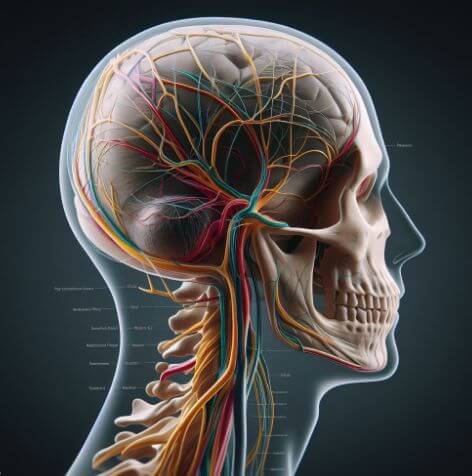Quick Overview
The inferior alveolar nerve (IAN) is a branch of the mandibular nerve, and responsible for sensory innervation of the lower teeth and gums, as well as the lower lip and chin. It also provides motor innervation to the mylohyoid muscle, which helps to elevate the floor of the mouth.

Table of Contents
Anatomy and Location
The IAN arises from the mandibular nerve deep within the infratemporal fossa. It then exits the skull through the mandibular foramen and enters the mandibular canal.
The IAN runs through the mandibular canal until it reaches the mental foramen, where it exits the mandible and divides into two terminal branches, i,e the mental nerve and the incisive nerve.
| Nerve | Description |
| Origin | Mandibular nerve |
| Branches | Mylohyoid nerve, Dental branches, Mental nerve, Incisive nerve |
| Supply | mylohyoid muscle, lower teeth and gums, lower lip and chin, incisor teeth |
Function of Inferior Alveolar Nerve
The primary function of the inferior alveolar nerve is to provide sensory innervation to the lower teeth, gums, and the mucous membranes lining the mouth.
It plays a vital role in transmitting sensory information, allowing individuals to perceive sensations such as pain, pressure, and temperature in the lower jaw and dental structures.
Branches
The IAN has several branches, which includes;
- Mylohyoid nerve: Supplies the mylohyoid muscle
- Dental branches: Supply sensory innervation to the lower teeth and gums
- Mental nerve: Exits the mandible through the mental foramen and provides sensory innervation to the lower lip and chin
- Incisive nerve: Remains within the mandible and provides sensory innervation to the incisor teeth.
Clinical Importance
The IAN is an important nerve in dentistry and maxillofacial surgery. It is often blocked with a local anesthetic before dental procedures such as extractions and root canals. The IAN can also be damaged during surgery in the lower jaw or during trauma to the face.
Damage to the IAN can result in loss of sensation in the lower teeth, gums, lip, and chin. It can also cause weakness of the mylohyoid muscle, which can lead to difficulty swallowing.
Associated Conditions
Several conditions and situations can impact the inferior alveolar nerve, which may include;
1- Impacted Wisdom Teeth: Wisdom teeth, also known as third molars, can sometimes impinge on the inferior alveolar nerve, leading to pain and discomfort.
2- Infections: Infections or abscesses in the lower jaw can irritate the nerve, causing pain and swelling in the affected area.
3- Injuries: Traumatic injuries to the lower jaw or mandible can result in nerve damage, leading to sensory disturbances or numbness in the lower face.
4- Neuropathies: Neuropathic conditions or diseases affecting the trigeminal nerve can indirectly impact the function of the inferior alveolar nerve, leading to sensory abnormalities.
Question
1. What is an Inferior Alveolar Nerve Block?
An Inferior Alveolar Nerve Block is a dental procedure in which local anesthesia is administered to temporarily block the inferior alveolar nerve’s function. This is commonly done to numb the lower jaw, teeth, and surrounding tissues during dental treatments to reduce pain and discomfort.
2. What Are the Complications of an Inferior Alveolar Nerve Block?
Complications of an Inferior Alveolar Nerve Block are generally rare but can include temporary numbness, pain, or swelling at the injection site. In very rare cases, more severe complications may occur, such as infection or injury to the nerve itself.
3. What Are the Symptoms of Inferior Alveolar Nerve Damage?
Symptoms of Inferior Alveolar Nerve Damage may include numbness or altered sensation in the lower lip, chin, teeth, or gums. Patients may also experience tingling, pain, or a “pins and needles” sensation in the affected area.
4. How is Inferior Alveolar Nerve Damage Treated?
Treatment for Inferior Alveolar Nerve Damage varies depending on the severity. In mild cases, observation and time may be sufficient for recovery. In more severe cases, treatment options may include medications, nerve regeneration therapies, or surgery.
5. Can Inferior Alveolar Nerve Damage Occur from Wisdom Tooth Extraction?
Yes, Inferior Alveolar Nerve Damage can occur as a complication of wisdom tooth extraction, especially if the wisdom tooth is located close to or in contact with the nerve. Dentists and oral surgeons take precautions to minimize this risk, but it can still happen.
6. What is the Typical Recovery Time for Inferior Alveolar Nerve Damage?
The recovery time for Inferior Alveolar Nerve Damage varies widely based on the extent of the injury. In mild cases, sensation may return within a few weeks to months. In more severe cases, it can take longer, and some individuals may experience permanent changes in sensation. Consulting with a healthcare provider or oral surgeon is essential for assessing and monitoring recovery.
